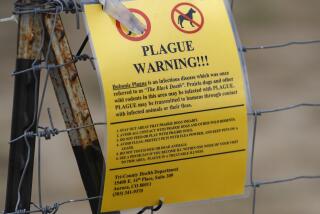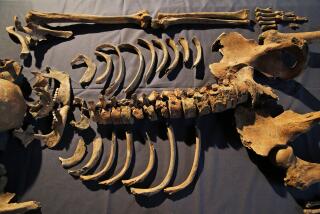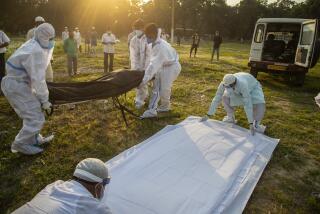Outbreak of Plague Is Now Under Control, India Says : Health: Epidemic has killed 41 in western city, caused mass exodus. Some fear spread of disease.
- Share via
NEW DELHI — Health officials reported Monday that India’s first outbreak of plague in nearly three decades is firmly under control, but they were still hunting carriers of the deadly bacillus who, they said, had become as dangerous as “human bombs.”
As of Monday, 41 deaths from pneumonic plague had been registered in the western city of Surat near the Arabian Sea coast, and 453 cases of the highly contagious disease were suspected in the city.
The officials called those numbers encouraging proof that the spread of the dreaded illness, which has already killed 12 million Indians this century, had been checked.
“It is down. It is under control,” said Dr. N. J. Kar, chief medical officer at the National Institute of Communicable Diseases in New Delhi.
No new deaths had been reported in the previous 24 hours, officials of the Health Ministry said Monday. Health Secretary M. S. Dayal had already given assurances that “there is going to be no large-scale outbreak.”
But others feared that the panicky exodus that had led to the outflow of up to 400,000 of Surat’s 2 million people since the epidemic was announced Thursday could spread the plague to the rest of India. Anyone carrying the bacterium might transmit it through a cough or sputum, medical officials said.
Dayal and other Indian government officials flatly denied that any cases had been registered so far outside Surat, saying tests of all suspected victims had proven negative.
But the Press Trust of India news agency reported Monday that in Dhule, 120 miles east of Surat, a man who had fled the epidemic and was being treated for plague had died.
In Rajkot, 150 miles northwest of Surat, one of several hundred people receiving treatment for plague-like symptoms died in a hospital, the agency said. In Ahmedabad, 120 miles north of Surat, six patients with similar symptoms were being kept in isolation.
In Bombay, 160 miles south of Surat, local health authorities quarantined 21 suspected plague victims in an isolation ward, United News of India said. Twelve were from Surat.
Pneumonic plague is one of the three forms of the feared pestilence known in the Middle Ages as the “Black Death.” In the 14th Century, plague killed an estimated 25 million people, or one-quarter the population of Europe.
Plague is spread to humans by fleas that have bitten rats infected with the bacillus Pasteurella pestis . In its pneumonic form, the infection leads to high fever, the vomiting of blood and the filling of the lungs with fluid. Death occurs within three to four days.
India’s last plague cases were registered in 1966, Kar said. Surat residents blamed their leaders for the resurgence of the disease.
“Municipal authorities allowed the garbage to pile up in the city after the recent monsoon floods,” said Pradip Saroi, who escaped over the weekend by taking the train to New Delhi. “They did not take any preventive measures, nor was DDT sprayed.”
The precise toll may never be known, since people in Surat’s poorer neighborhoods are believed to have cremated suspected plague victims without reporting their deaths. At least 93 people died this month while undergoing treatment for symptoms of malaria, dengue fever, typhoid and cholera. Doctors said many of those deaths may have been caused by plague.
Despite its macabre reputation, plague can be cured if a victim is rapidly given antibiotics. Over the weekend, 1,200 members of a medical “strike force” handed out 1.2 million tablets of tetracycline in Surat as officials rushed in millions of additional doses.
Around the Civil Hospital, paramilitary troops were deployed to prevent the hundreds who had been hospitalized from leaving. According to Dayal, 57 people fled the hospital during the first two days of the epidemic when they saw other people die.
A senior Health Ministry official called the infected escapees “human bombs,” and police sent teams into infected neighborhoods to track them down.
The plague returned to India for the first time in 28 years when a village in the Beed district of the neighboring state of Maharashtra reported its first case of bubonic plague last month. The outbreak was blamed on a surge in the rat population drawn by relief food meant to help victims of last year’s destructive earthquake.
More than 90 people were infected, but the bubonic outbreak was brought under control by insecticide spraying and antibiotics.
Bubonic plague constitutes about three-quarters of all plague cases, and it is less infectious and often milder in its symptoms than the pneumonic variety.
Other nations took steps to guard against spread of the plague, and the United States, Russia and Japan offered to help fight the disease. U.S. officials were reported monitoring airports to watch for passengers arriving with the plague. Hong Kong, Pakistan, South Korea, Thailand and the United Arab Emirates said they would examine travelers from India.
More to Read
Sign up for Essential California
The most important California stories and recommendations in your inbox every morning.
You may occasionally receive promotional content from the Los Angeles Times.













